Get ready to have your heart melted by these 10 adorable animals with big, captivating eyes! From the wide-eyed Tarsiers to the enchanting Fennec Fox, these cuties are bound to make you fall head over heels in love. Whether you’re a fan of the slow-motion antics of the Slow Loris or the mesmerizing gaze of the Northern Saw-Whet Owl, this list has something for everyone. So, prepare yourself for a dose of cuteness overload as we explore the world of these irresistibly charming creatures. Get ready to say “aww” as we dive into the world of 10 Cute Animals With Big Eyes You Will Fall in Love With!
1. Tarsiers: The Nighttime Navigators
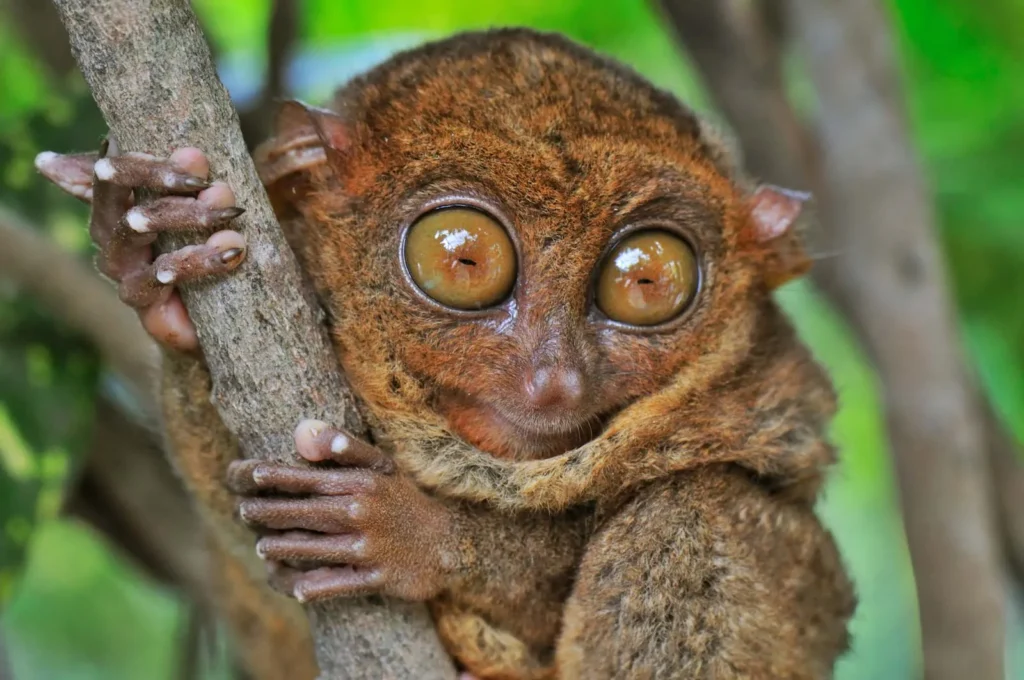
tarsiers
Stepping into the dense forests of Southeast Asia, you might find your gaze drawn to a pair of gigantic eyes gleaming in the dark. These belong to the diminutive but intriguing Tarsiers, members of the family Tarsiidae. Their eyes, a captivating spectacle, are an extraordinary adaptation that has evolved to equip these primates for nocturnal life.
Imagine this – their eyes are actually larger than their brains! Yes, you read it right. This anatomical quirk is what equips these tiny primates to be successful hunters, even in low light conditions. Their eyes, much like high-resolution night vision goggles, can spot an insect fluttering in the dimmest of light.
Check out: What Eats Octopus? Discover the Top 12 Predators That Feast on These Clever Cephalopods!
However, there’s a catch. These eyes are fixed in their skulls, preventing them from moving or turning. But nature always finds a way. To make up for this, Tarsiers have evolved the extraordinary ability to rotate their heads almost 180° in each direction. This allows them to scan their surroundings thoroughly, just like a radar system, without moving their bodies.
Fun fact: The Tarsiers’ head rotation ability is reminiscent of the comic book superhero, Owlman, who boasts similar flexibility!
| Scientific Name | Type of Animal | Location | Special Trait | Diet |
|---|---|---|---|---|
| Tarsius spp. | Mammal | Forests of Southeast Asia – Philippines, Borneo, and Sumatra | Big eyes larger than their brains, can rotate head 180° in each direction | Insectivores – feeds primarily on insects |
Stay tuned for more on our journey through the world of adorable animals with big eyes. Up next, we’ll be meeting the Slow Loris, another nocturnal primate whose innocent eyes hide a surprising secret.
2. The Innocent yet Deadly: Slow Loris
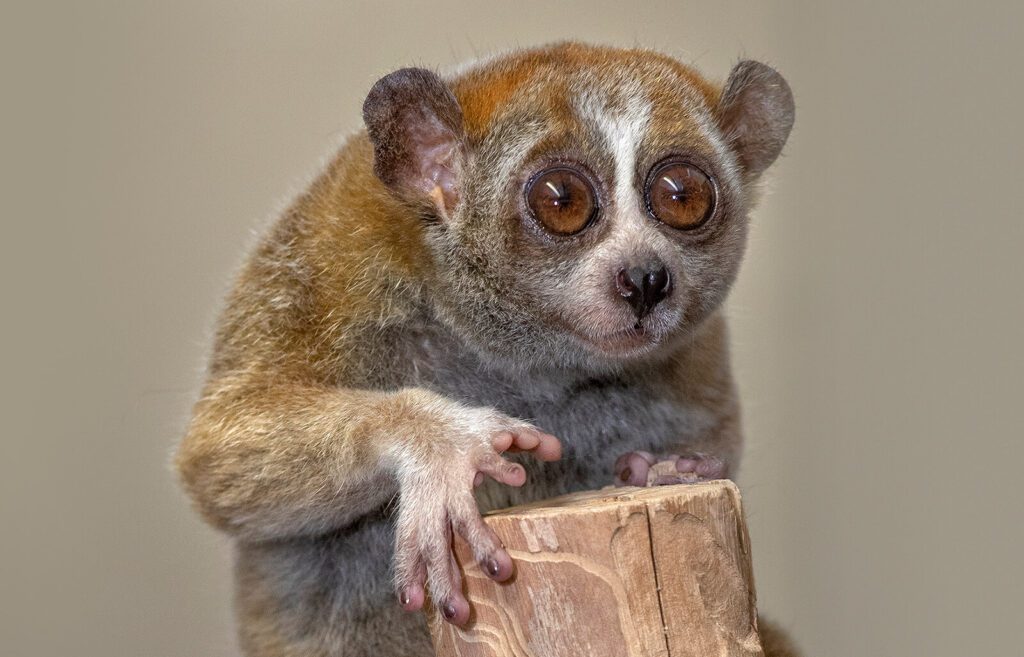
slow loris
Among the lush, verdant landscapes of Southeast Asia, a peculiar nocturnal creature emerges when the sun goes down. Meet the Slow Loris, or scientifically known as Nycticebus spp., a captivating mammal with eyes that are as enchanting as they are deceiving.
What makes this creature so mesmerizing? Their large, round eyes that shine like twin moons in the darkness. These eyes are not just for show, they serve a powerful purpose. They are the Slow Loris’ guiding light, helping them navigate the dense, tropical forests they call home. With these eyes, they can spot an unsuspecting insect or a juicy fruit from a distance, making them efficient hunters and gatherers.
Fun Fact: The Slow Loris uses its large, round eyes to navigate its environment in the dark and spot potential prey. It’s a case of beauty meeting functionality.
However, don’t let their innocent looks fool you. The Slow Loris has a secret weapon that sets it apart from most other mammals – a toxic bite. This seemingly harmless creature can produce a lethal toxin from glands located on the insides of its elbows. This toxin can be used in two ways – for defense and for hunting.
When threatened, the Slow Loris can spread this toxin on its fur, creating a protective barrier that deters predators. Alternatively, they can mix the toxin with their saliva, transforming their bite into a deadly weapon.
Did You Know? The Slow Loris is one of the few mammals with a toxic bite. Its poison is produced in glands located on the insides of its elbows.
The Slow Loris is a fascinating creature that perfectly embodies the element of surprise. Beneath its cute, wide-eyed exterior lies a deadly secret, proving that appearances can sometimes be deceiving. But remember, while this creature is certainly captivating, it’s best to admire it from a distance.
3. Galago: The Agile Nocturnal Acrobat
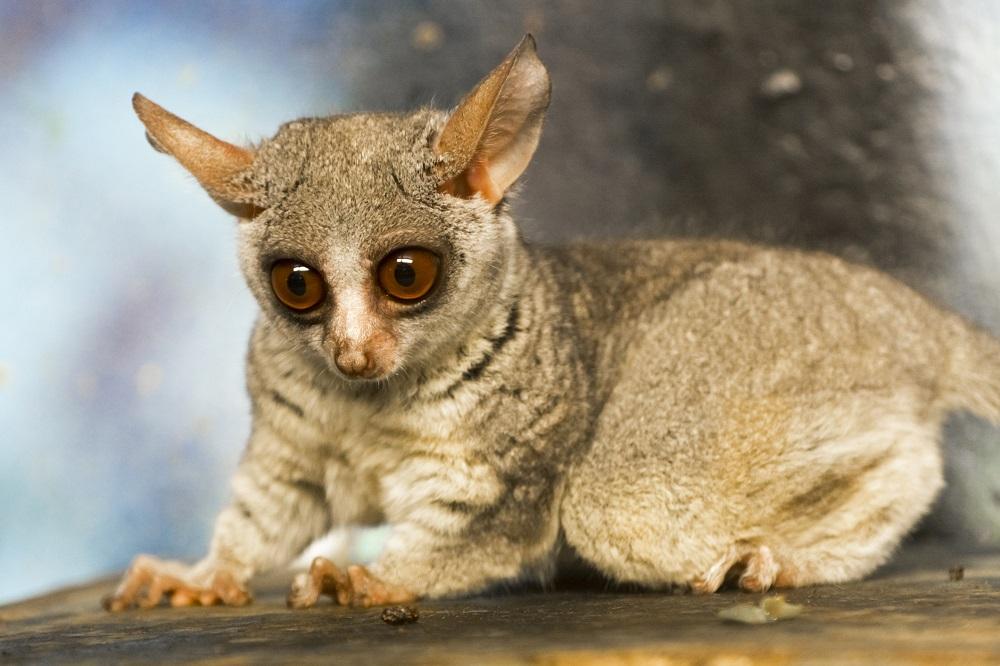
galago
If you thought the Tarsiers and Slow Lorises were fascinating, brace yourself for another entrancing creature with eyes that put the stars to shame. The Galago, affectionately known as the Bush Baby, belongs to the Galagidae family. This enchanting mammal makes its home amidst the green canopies and vast savannas of Sub-Saharan Africa.
These adorable creatures of the night have incredibly large, round eyes that shine brightly in the dark, reminiscent of two tiny moon globes. Their eyes, so large that they glow in torchlight, are not just for show. They serve a vital purpose – to navigate the dark forest expanses and to hunt insects with an assassin’s precision. Just imagine, in the absolute darkness of the African forests, the gleaming eyes of the Bush Baby are the only thing that stands between it and its next meal.
But the magic doesn’t stop at their eyes. The Galagos are not just mere observers of the forest nightlife; they are agile participants. Thanks to their powerful hind legs, they can leap between trees with the grace of a ballet dancer. And when they decide to really show off, they can jump distances of up to 2.25 meters (7.4 feet). That’s like leaping over a tall human with room to spare!
So, the next time you find yourself wandering through the Sub-Saharan forests at night, listen carefully. You might just hear the plaintive cries of the Bush Baby echoing through the darkness, and if you’re lucky enough, you might catch a glimpse of two glowing eyes staring back at you from the depth of the forest.
4. The Enchanting Northern Saw-Whet Owl: A Master of Night Vision
Imagine being cocooned in the heart of a tranquil North American forest as the sun dips below the horizon. The air is filled with a symphony of nocturnal whispers, amongst which, you might just hear the repetitive tooting whistle of the Northern Saw-Whet Owl. This isn’t just your ordinary hoot; it’s a rhythmic serenade, reminiscent of a saw being sharpened, hence the owl’s peculiar name.
Standing out against the canvas of the night are the owl’s captivating, round, yellow eyes, a pair of biological marvels that lend the owl not just its hypnotic charm but also an extraordinary hunting prowess. Dominating its facial features, these eyes are equipped with a high rod-to-cone ratio, enhancing its night vision to an awe-inspiring degree. This allows the Northern Saw-Whet Owl to detect the faintest rustle of a field mouse or the subtlest twitch of an insect beneath the dense forest floor.
Did you know? The Northern Saw-Whet Owl’s eyes are so large that they are actually fixed in their sockets. But fear not, nature has a way of balancing things out. To compensate for this, owls have additional neck vertebrae allowing them to rotate their heads up to an astounding 270°, providing a panoramic field of view. It’s as if they possess their very own built-in periscope!
With its large eyes acting like spotlight beams in the dark, and its head rotating almost like a lighthouse, the Northern Saw-Whet Owl is a perfect embodiment of nature’s ingenuity. It’s no wonder that this adorable bird of prey has become an iconic symbol of the nocturnal world, making it one of the most endearing creatures with big eyes you’ll undoubtedly fall in love with.
5. The Enchanting Sugar Glider
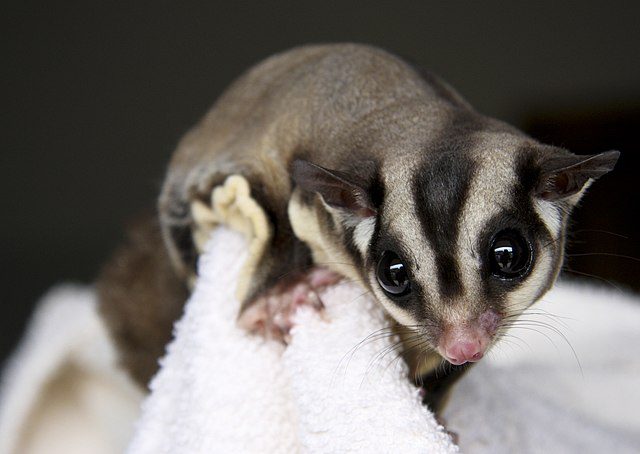
sugar glider
From the sunburnt outbacks of Australia to the lush forests of New Guinea, there thrives a creature of extraordinary ability and charm—the Sugar Glider. A nocturnal marsupial that has captured the hearts of animal lovers worldwide, the Sugar Glider is a marvel of evolution with its big, mesmerizing, dark eyes that twinkle under the moonlight.
At first glance, what stands out about this creature, apart from its captivating eyes, is the patagium—a stretchy skin flap spanning from its forelimbs to its hindlimbs. This distinctive feature allows the Sugar Glider to take daring leaps between trees, transforming what would be a fall into an elegant glide. Similar to our previous nocturnal friends, the Galago and the Northern Saw-Whet Owl, the Sugar Glider’s large eyes play a crucial role in its survival, providing excellent night vision to navigate the dark forest canopy and spot food sources such as nectar, sap, and insects.
Read about: Are Hawks Friendly? Discover the Surprising Truth and Find Out if You Can Keep Hawks as Pets
Although their name suggests otherwise, Sugar Gliders are not capable of true flight. Instead, they’ve mastered the art of gliding, using their patagium like a parachute to cover distances of over 150 feet in a single leap. This unique ability, coupled with their maneuverability and precision, makes them one of nature’s most intriguing aerial acrobats.
Did you know? While they’re called “gliders,” these animals don’t truly fly. They use their patagium to glide, covering distances of over 150 feet in a single leap and maneuvering with impressive accuracy. – Fun Facts About Sugar Gliders
Beyond their ecological role, Sugar Gliders have become a favorite among exotic pet enthusiasts, charmed by their inquisitive nature and captivating eyes. However, it’s important to remember that these creatures require specific care and should only be considered as pets under appropriate conditions.
Indeed, the Sugar Glider is a testament to nature’s creativity, showing us that even in the darkness of the night, there are eyes that shine bright, navigating the shadows with grace and agility.
6. Chinchillas: The Plush Pets of the Andes
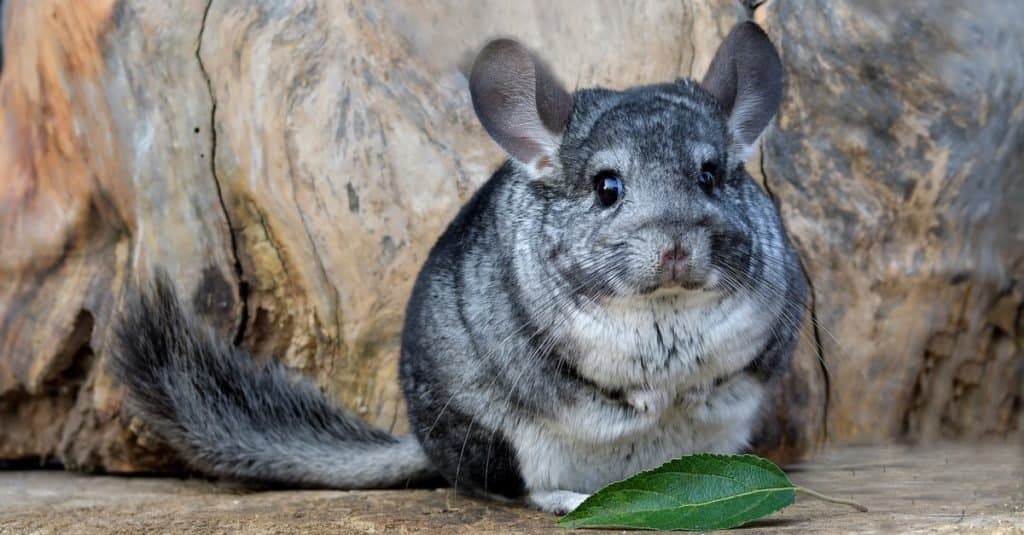
chinchillas
As we journey from the nocturnal forests, home to the Northern Saw-Whet Owl and the Sugar Glider, let’s shift our gaze to the rugged terrains of South America. Nestled high in the Andes Mountains, we find the charming Chinchillas. These endearing creatures, with their big, black eyes that shimmer like obsidian, have an uncanny ability to make hearts melt.
Chinchillas are not just known for their captivating eyes but also their plush, luxurious fur. This fur isn’t just for show, though – it serves a crucial survival function. So dense it can suffocate fleas and other parasites, their fur is a natural armor against the harsh conditions of their mountainous habitats. In the wild, these cute animals maintain their coats by indulging in dust baths. They roll in fine volcanic ash, a natural method to absorb oils and cleanse their fur – a spectacle that is both fascinating and endearing to observe.
Did you know? A chinchilla’s fur is denser than any other land mammal’s. Each hair follicle sprouts about 60 hairs.
But why such big eyes for these little creatures? The answer lies in their nocturnal nature. The world of a Chinchilla comes alive in the twilight. Their oversized eyes capture every ray of the waning sunlight, helping them forage for food and stay alert to predators in the rocky, arid terrains of the Andes. Each evening, their eyes transform into powerful biological torchlights, guiding them through the dimly lit landscapes.
Their curiosity and gentle demeanor have not only helped them survive in the wild but have also made them popular pets worldwide. However, prospective chinchilla owners should remember that these adorable creatures require special care to thrive in a domestic setting.
So, next time you look into the large, black eyes of a chinchilla, remember, you’re peering into a well-adapted survival tool honed by nature over millions of years.
Stay tuned as we continue our journey, exploring more cute animals with big eyes. Up next, we’ll be flying over to Japan to meet the adorable Japanese Flying Squirrel.
7. The Elusive Acrobat of the Japanese Forests: The Japanese Flying Squirrel
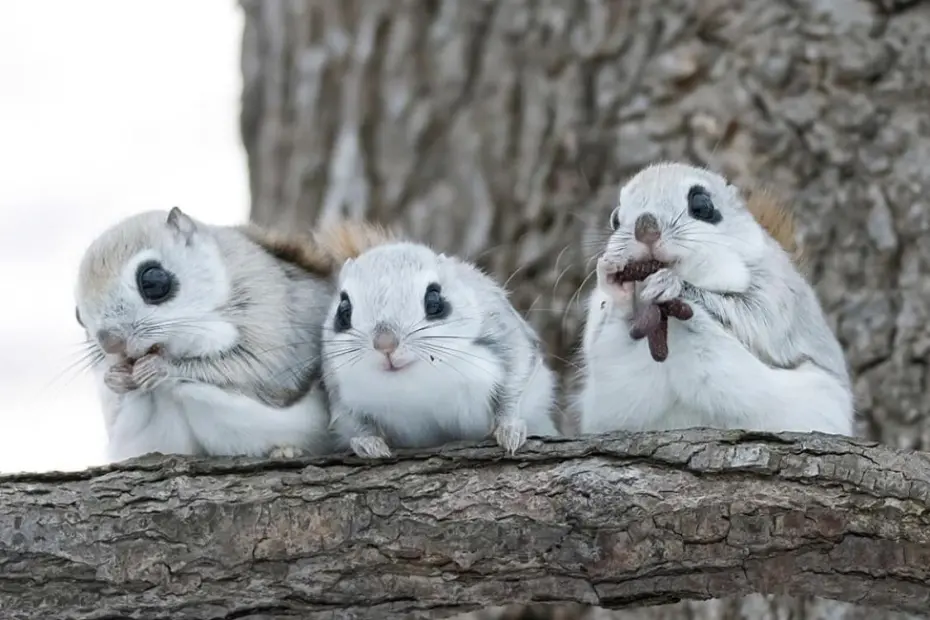
japanese flying squirrel
Imagine a hushed, moonlit night in the dense forests of Japan. The only sounds that punctuate the silence are the rustling leaves and the occasional call of a distant animal. Suddenly, a soft shadow flits through the trees, barely noticeable to the untrained eye. This is none other than the captivating, nocturnal Japanese Flying Squirrel, a true marvel of nature.
Unlike its name suggests, this enchanting creature doesn’t actually fly. Much like the Sugar Glider, it’s an expert glider, possessing a remarkable adaptation: a skin flap known as the patagium. This stretchy membrane spans from its wrists to its ankles, allowing it to make impressive leaps between trees and glide over distances that would seem impossible for a creature its size.
One of the most striking features of the Japanese Flying Squirrel is its large, expressive eyes. These orbs, glowing like twin moons in the darkness, serve a critical role in the squirrel’s nocturnal lifestyle. The large eyes help it stay vigilant against predators lurking in the shadows and aid in the precise identification of food sources amidst the forest’s nocturnal murmur.
The Japanese Flying Squirrel is a true embodiment of nature’s creativity—an elusive phantom of the night sky, a masterful acrobat, and an endearing creature you’ll surely fall in love with.
So, the next time you find yourself under the dense canopy of the Japanese forests at night, pause and listen. You just might catch a glimpse of this adorable critter sailing swiftly through the treetops, its large eyes reflecting the moonlight, adding a touch of magic to the tranquil night.
8. The Vibrant Visionary: Peacock Mantis Shrimp
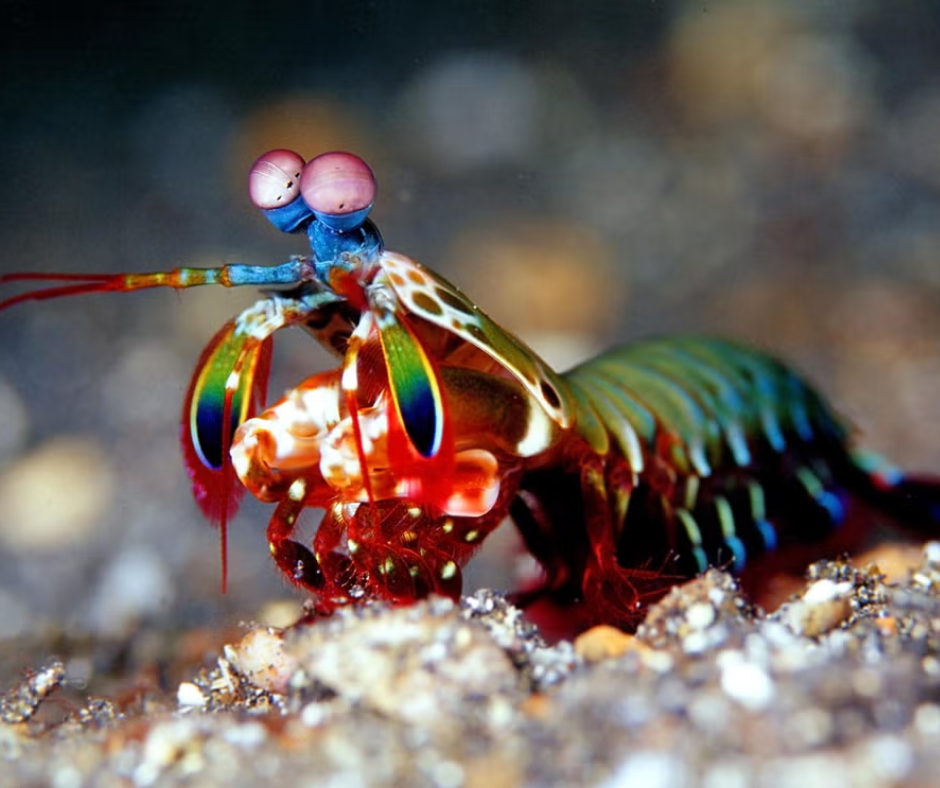
peacock mantis shrimp
Drifting away from the land-dwelling creatures to the mesmerizing depths of the tropical waters of the Indian and Pacific Oceans, we encounter a creature that is a feast for the eyes – the Peacock Mantis Shrimp. With a body that is a canvas of vibrant colors akin to an artist’s palette, this crustacean is a true spectacle in the world of marine life.
However, it’s not just the body of the Peacock Mantis Shrimp that is a riot of colors. The spotlight of our interest here is its large, expressive eyes. These eyes, a marvel of nature, are considered among the most advanced in the animal kingdom. Much like how the large eyes of the Chinchillas and the Japanese Flying Squirrel aid their nocturnal navigation, the Peacock Mantis Shrimp’s eyes have a unique role to play.
“They can detect ten times more color than a human, including ultraviolet light.”
Yes, you read that right. These eyes, equipped with an impressive capability, can discern a spectrum of colors that is far beyond human comprehension. This includes the ultraviolet light, a spectrum of light invisible to human eyes.
But, the Peacock Mantis Shrimp’s uniqueness doesn’t end with its extraordinary visual prowess. It is also known for one of the most powerful punches in nature, a fact that is as fascinating as it is intimidating.
Imagine the force of a bullet concentrated in the punch of a shrimp! That’s the Peacock Mantis Shrimp for you, striking with such speed and generating enough force to shatter aquarium glass. This powerful punch, combined with its extraordinary vision, makes it a formidable predator in its habitat.
While the Peacock Mantis Shrimp might not fit into the conventional definition of ‘cute’, it is undoubtedly a visually captivating creature. Its vibrantly colored body and large, expressive eyes are sure to leave you spellbound, adding another fascinating chapter to our exploration of cute animals with big eyes.
9. Ring-Tailed Lemur: The Mesmerizing Madagascan Marvel
Imagine you’re weaving through the dense forests of Madagascar when suddenly, a pair of large, amber eyes catch your attention. There, amidst the fluttering leaves and the sounds of nature, you spot a creature that’s every bit as enchanting as the island it calls home: the Ring-Tailed Lemur.
The Ring-Tailed Lemur, with its expressive, almost human-like eyes, is not only one of the most recognized but also one of the most beloved species of Madagascar. Their eyes, which mirror the golden hues of a setting sun, serve a crucial purpose in their day-to-day activities. They’re not just decorative but functional, aiding these agile beings in their daytime foraging and socializing endeavors, as well as their nighttime escapades.
But their allure doesn’t stop at their striking gaze. As their name suggests, these lemurs possess iconic, intricately striped tails. This remarkable feature, a carousel of alternating black and white bands, adds to their distinctive charm, making them a symbol of Madagascan wildlife.
What sets the Ring-Tailed Lemur apart even more is its unique lineage. While they are primates, these creatures diverge from the family tree of monkeys and apes. The isolation of Madagascar has played a significant role in their evolution, opening a pathway for them to adapt and thrive in ways unlike their primate cousins.
Did you know? The isolation of Madagascar allowed the Ring-Tailed Lemur to evolve in diverse ways, resulting in it being a part of over 100 different species of lemurs!
These captivating creatures, with their endearing eyes and iconic tails, serve as a testament to the beauty and diversity of life that thrives on this isolated island. The Ring-Tailed Lemur is undoubtedly a charming emissary of Madagascar, capturing hearts worldwide with its big, amber eyes and enchanting persona.
10. Fennec Fox: The Desert’s Enigmatic Charmer
Our journey through the fascinating world of animals with large eyes brings us to the arid landscapes of North Africa and the Sinai Peninsula, home to the captivating Fennec Fox. With eyes as big as the twilight sky and ears that are extraordinarily large, this desert dweller seems as if it has leaped straight out of a whimsical fairy tale.
These magnificent orbs of vision, dark and expressive, are a testament to the fox’s adaptation to its environment. The Fennec Fox is predominantly a twilight creature, a time when the desert’s harsh sun gives way to a serene, dimly lit landscape. These big eyes serve as powerful spotlights, creating a visual advantage when hunting prey or navigating the vast desert terrain in low light. It’s a testament to nature’s ingenuity, using every possible advantage to ensure survival.
But the charm of the Fennec Fox doesn’t end with its eyes. Its oversized ears, a distinctive feature, serve dual purposes. In the scorching desert heat, these ears act as natural air conditioners, dissipating heat to help the fox maintain a comfortable body temperature. But they also function as powerful radar dishes, capturing the faintest sounds of distant prey. This dual functionality showcases the remarkable adaptability of this creature to its environment.
These enchanting characteristics make the Fennec Fox a favorite among wildlife enthusiasts. There’s a certain allure to this desert dweller, with its big eyes, large ears, and an uncanny ability to thrive in one of the most inhospitable environments on Earth. This allure, though rooted in the fox’s survival adaptations, also serves as a reminder of the diverse beauty found in the animal kingdom.
So, let’s continue our journey, exploring the captivating world of animals with big eyes and the tales they tell of evolutionary brilliance and survival.
Tarsiers have eyes that are larger than their brains to help them spot prey in dim light and maximize the absorption of light.
Galagos’ large, round eyes are an adaptation for their nocturnal lifestyle. They help the galagos navigate in the dark and spot prey.
The Northern Saw-Whet Owl’s large, round, yellow eyes have a high rod-to-cone ratio, enhancing its night vision.
Fennec foxes have big, dark eyes that are well-suited for twilight activities and spotting prey in dim light.

